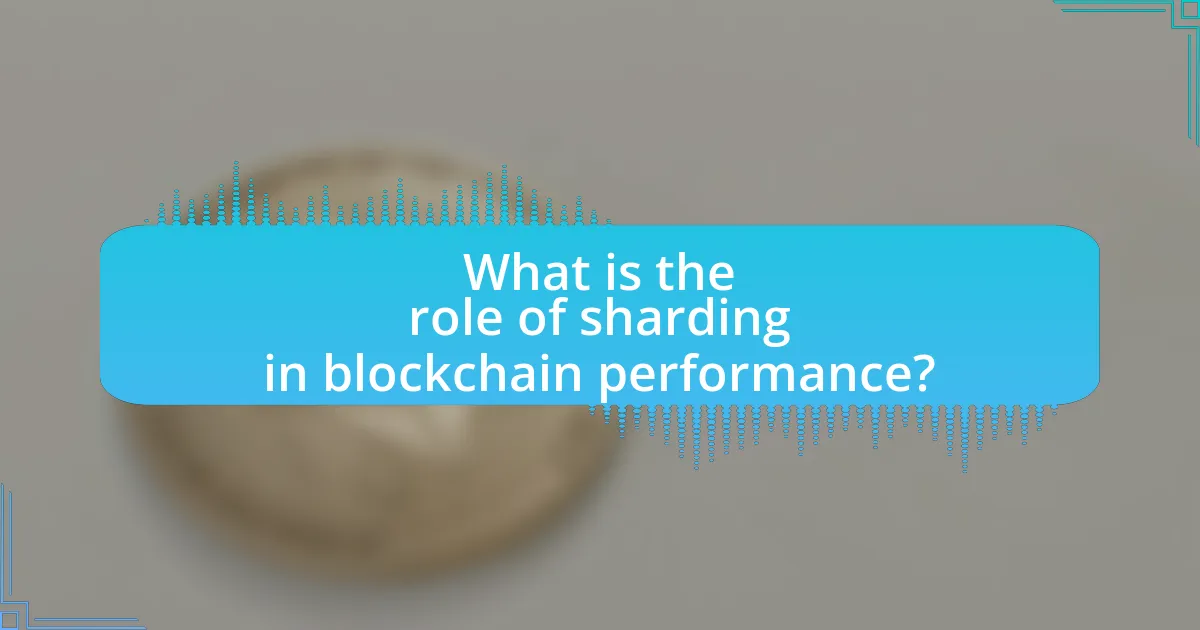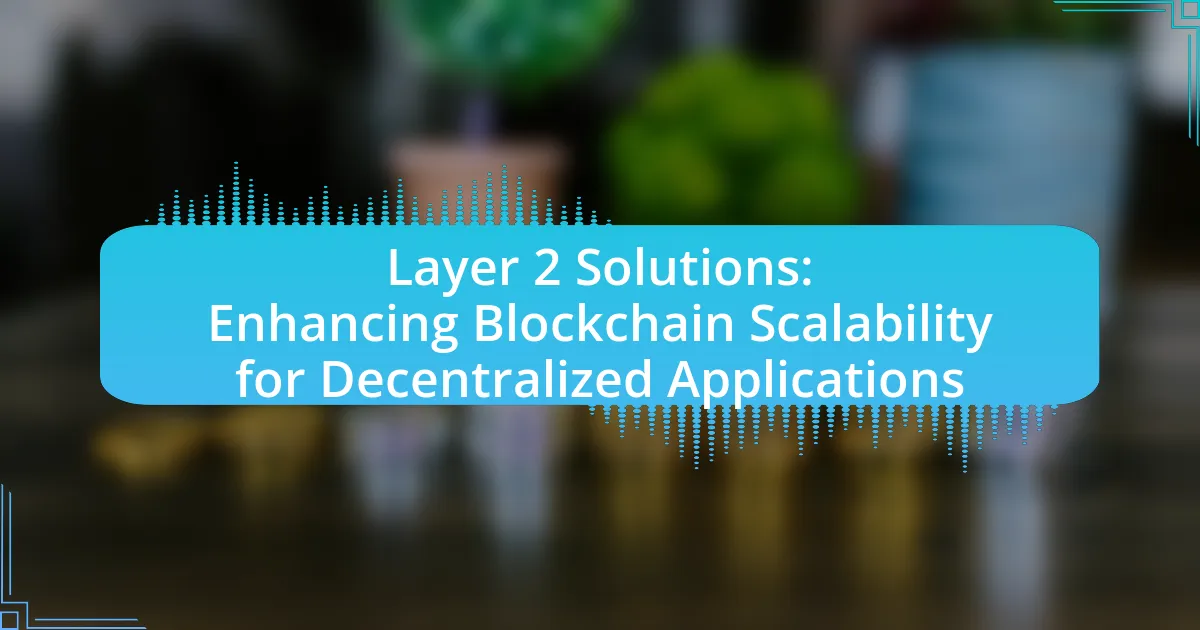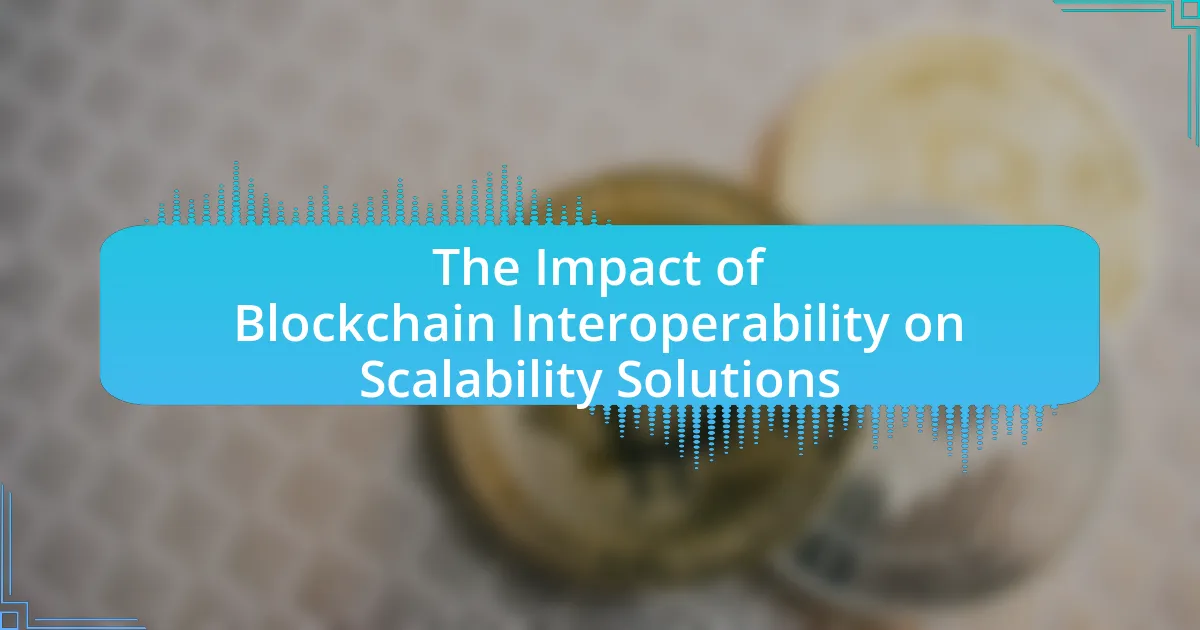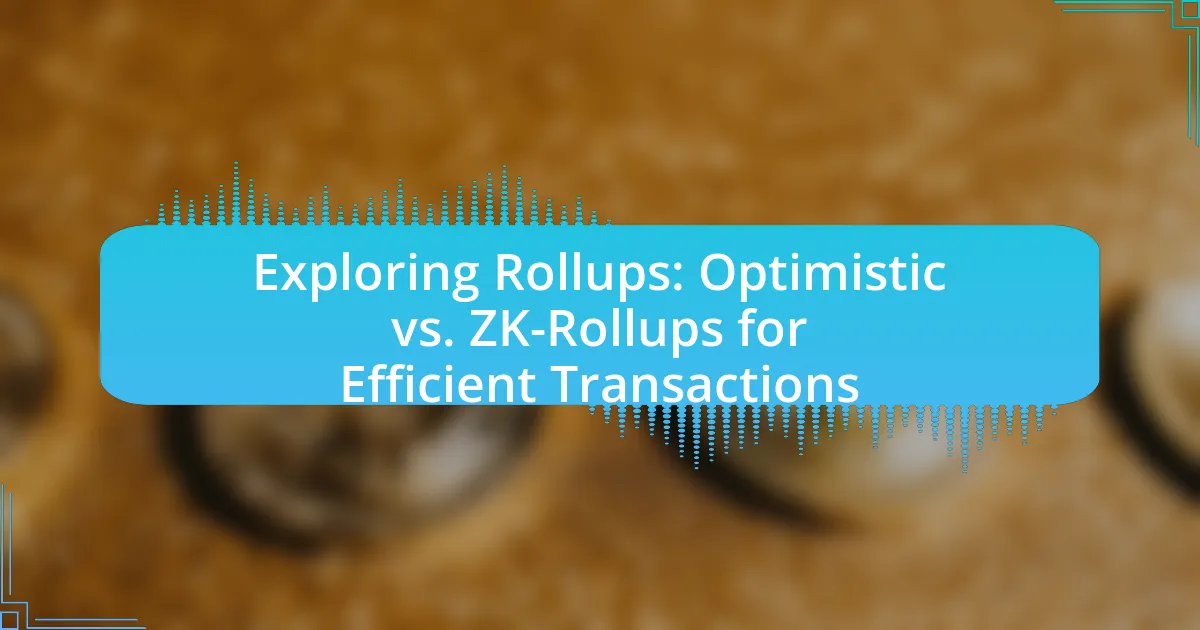Sharding is a crucial technique in blockchain technology that enhances performance by dividing the network into smaller segments, known as shards, which allows for parallel processing of transactions. This method significantly increases transaction throughput and reduces latency, addressing scalability issues faced by traditional blockchain structures. The article explores the key components of sharding, its impact on transaction speed and consensus mechanisms, as well as the challenges and security concerns associated with its implementation. Additionally, it discusses the future prospects of sharding in emerging blockchain projects and best practices for effective integration.

What is the role of sharding in blockchain performance?
Sharding enhances blockchain performance by dividing the network into smaller, manageable pieces called shards, allowing parallel processing of transactions. This parallelization significantly increases transaction throughput and reduces latency, as each shard can process its own transactions independently. For instance, Ethereum 2.0 aims to implement sharding to improve scalability, targeting thousands of transactions per second compared to the current limitations of the Ethereum network. By distributing the workload across multiple shards, sharding effectively alleviates congestion and enhances overall network efficiency.
How does sharding improve scalability in blockchain networks?
Sharding improves scalability in blockchain networks by dividing the network into smaller, manageable pieces called shards, allowing multiple transactions to be processed simultaneously. This parallel processing significantly increases the throughput of the network, as each shard can handle its own set of transactions independently. For example, Ethereum 2.0 plans to implement sharding to enhance its capacity from approximately 30 transactions per second to potentially thousands, demonstrating the effectiveness of this approach in scaling blockchain performance.
What are the key components of sharding in blockchain?
The key components of sharding in blockchain include data partitioning, parallel processing, and cross-shard communication. Data partitioning involves dividing the blockchain’s data into smaller, manageable pieces called shards, which allows for more efficient storage and retrieval. Parallel processing enables multiple transactions to be processed simultaneously across different shards, significantly increasing throughput. Cross-shard communication is essential for maintaining consistency and coordination between shards, ensuring that transactions affecting multiple shards are executed correctly. These components collectively enhance the scalability and performance of blockchain networks by reducing congestion and improving transaction speeds.
How does sharding differ from traditional blockchain structures?
Sharding differs from traditional blockchain structures by partitioning the blockchain network into smaller, manageable pieces called shards, which allows for parallel processing of transactions. In traditional blockchains, every node processes every transaction, leading to scalability issues as the network grows. Sharding enhances performance by enabling each shard to handle its own transactions and smart contracts independently, thereby increasing throughput and reducing latency. This method has been shown to significantly improve scalability, as evidenced by projects like Ethereum 2.0, which aims to implement sharding to support thousands of transactions per second compared to the limited capacity of traditional blockchains.
Why is sharding important for transaction speed?
Sharding is important for transaction speed because it allows a blockchain network to process multiple transactions simultaneously by dividing the workload across different nodes. This division reduces congestion and enhances throughput, enabling the network to handle a higher volume of transactions per second. For instance, Ethereum’s proposed sharding mechanism aims to increase its transaction capacity from around 30 transactions per second to potentially thousands, significantly improving overall performance.
What impact does sharding have on transaction throughput?
Sharding significantly increases transaction throughput by allowing parallel processing of transactions across multiple shards. Each shard operates independently, enabling the network to handle a larger number of transactions simultaneously compared to a non-sharded architecture. For instance, Ethereum 2.0’s implementation of sharding aims to enhance its transaction capacity from approximately 30 transactions per second to potentially thousands, depending on the number of shards deployed. This scalability is crucial for accommodating growing user demands and application needs in blockchain networks.
How does sharding reduce latency in blockchain operations?
Sharding reduces latency in blockchain operations by dividing the network into smaller, manageable segments called shards, allowing parallel processing of transactions. Each shard processes its own transactions independently, which significantly decreases the time required for transaction validation and confirmation. For instance, in a traditional blockchain, every node must validate every transaction, leading to bottlenecks. In contrast, sharding enables only a subset of nodes to handle transactions for their specific shard, thus enhancing throughput and reducing the overall time for transaction finality. This method has been shown to improve scalability, as evidenced by research indicating that sharding can increase transaction speeds by orders of magnitude compared to non-sharded systems.
What challenges does sharding present in blockchain implementation?
Sharding presents several challenges in blockchain implementation, primarily related to security, complexity, and data consistency. Security risks arise because sharding can make it easier for attackers to target specific shards, potentially compromising the integrity of the entire network. Complexity increases as developers must manage multiple shards, requiring sophisticated protocols for communication and coordination among them. Additionally, ensuring data consistency across shards is challenging, as transactions may need to be validated across different shards, complicating consensus mechanisms. These challenges must be addressed to effectively leverage sharding for improved blockchain performance.
What are the security concerns associated with sharding?
Sharding introduces several security concerns, primarily related to data availability, increased attack vectors, and potential for collusion among validators. In a sharded blockchain, each shard processes a subset of transactions, which can lead to scenarios where a malicious actor targets a specific shard to disrupt its operations. This fragmentation can also make it easier for attackers to execute Sybil attacks, where they create multiple identities to gain control over a shard. Furthermore, if a shard becomes compromised, the integrity of the entire network can be at risk, as the compromised shard may not be able to validate transactions accurately. These concerns highlight the need for robust security measures and consensus protocols to mitigate risks associated with sharding in blockchain systems.
How can network fragmentation affect sharding efficiency?
Network fragmentation can significantly reduce sharding efficiency by causing delays in communication between shards. When a network is fragmented, data packets may take longer to reach their destination due to increased latency and potential packet loss. This inefficiency can lead to slower transaction processing times and hinder the overall performance of the blockchain. For instance, studies have shown that fragmented networks can increase the time required for consensus mechanisms, as shards may struggle to synchronize effectively. Consequently, the intended benefits of sharding, such as improved scalability and throughput, may not be fully realized in a fragmented network environment.
How does sharding interact with consensus mechanisms?
Sharding interacts with consensus mechanisms by dividing the blockchain network into smaller, manageable segments called shards, which allows for parallel processing of transactions. This division enhances scalability, as each shard can reach consensus independently, reducing the overall time required for transaction validation across the entire network. For instance, in Ethereum 2.0, sharding is designed to work alongside the Proof of Stake consensus mechanism, enabling multiple validators to process transactions simultaneously within different shards, thereby increasing throughput and efficiency. This interaction is crucial for improving blockchain performance, as it allows networks to handle a higher volume of transactions without compromising security or decentralization.
What are the implications of sharding on proof-of-work and proof-of-stake systems?
Sharding significantly impacts both proof-of-work (PoW) and proof-of-stake (PoS) systems by enhancing scalability and transaction throughput. In PoW systems, sharding can alleviate network congestion by distributing the workload across multiple shards, allowing parallel processing of transactions, which can lead to faster confirmation times. For instance, Ethereum’s transition to sharding aims to increase its transaction capacity from around 30 transactions per second to potentially thousands.
In PoS systems, sharding similarly improves scalability by enabling validators to focus on specific shards rather than the entire network, thus reducing the computational burden and energy consumption associated with validating transactions. This can lead to a more efficient consensus process, as seen in projects like Ethereum 2.0, which incorporates sharding to enhance its PoS mechanism.
Overall, sharding’s implications for both PoW and PoS systems include improved scalability, reduced latency, and increased efficiency, which are critical for the future growth and usability of blockchain networks.
How can sharding enhance or hinder consensus processes?
Sharding can enhance consensus processes by increasing scalability and reducing the load on individual nodes, allowing for faster transaction processing and improved network efficiency. In sharded blockchain systems, the network is divided into smaller, manageable pieces, or shards, which can process transactions in parallel. This parallel processing reduces the time required for consensus since each shard only needs to reach agreement on a subset of transactions rather than the entire network.
However, sharding can also hinder consensus processes by introducing complexities in maintaining cross-shard communication and ensuring data consistency. When transactions span multiple shards, it can complicate the consensus mechanism, potentially leading to increased latency and the risk of inconsistencies if not managed properly. For instance, if a transaction requires validation from multiple shards, the time taken to achieve consensus across those shards can negate the benefits of sharding.
Thus, while sharding can significantly enhance scalability and efficiency in blockchain networks, it also poses challenges that can hinder the effectiveness of consensus processes if not carefully designed and implemented.
What are the future prospects of sharding in blockchain technology?
The future prospects of sharding in blockchain technology are highly promising, as it significantly enhances scalability and transaction throughput. Sharding allows a blockchain network to partition its data into smaller, manageable pieces, or “shards,” which can be processed simultaneously by different nodes. This parallel processing capability is expected to address the scalability limitations faced by many current blockchain systems, such as Ethereum, which has been working on implementing sharding to improve its performance. Research indicates that sharding can potentially increase transaction speeds by orders of magnitude, enabling blockchains to handle thousands of transactions per second, thereby making them more viable for mainstream applications.
How are emerging blockchain projects integrating sharding?
Emerging blockchain projects are integrating sharding by dividing their networks into smaller, manageable pieces called shards, which allows for parallel processing of transactions. For instance, projects like Ethereum 2.0 and Zilliqa utilize sharding to enhance scalability and throughput, enabling them to handle thousands of transactions per second. Ethereum 2.0 plans to implement sharding in its transition to a proof-of-stake consensus mechanism, which will significantly increase its capacity. Zilliqa, on the other hand, has already demonstrated sharding in its mainnet, achieving a throughput of over 2,828 transactions per second during its initial launch. These implementations showcase how sharding can effectively improve blockchain performance by reducing congestion and increasing efficiency.
What innovations could enhance sharding effectiveness in the future?
Innovations such as adaptive sharding algorithms, improved consensus mechanisms, and enhanced data availability proofs could significantly enhance sharding effectiveness in the future. Adaptive sharding algorithms can dynamically adjust shard sizes and configurations based on network conditions, optimizing resource allocation and performance. Improved consensus mechanisms, like those utilizing proof-of-stake or hybrid models, can reduce latency and increase throughput across shards. Enhanced data availability proofs, which ensure that data is accessible and verifiable across shards, can mitigate risks of data unavailability and improve overall reliability. These innovations are supported by ongoing research in blockchain scalability, such as the work by Buterin et al. on Ethereum 2.0, which emphasizes the importance of these advancements for effective sharding implementation.
What best practices should be followed when implementing sharding in blockchain?
When implementing sharding in blockchain, best practices include ensuring data consistency across shards, optimizing shard size for performance, and implementing robust security measures. Data consistency is crucial as it prevents discrepancies between shards, which can lead to vulnerabilities; for instance, using consensus algorithms that maintain state across shards can enhance reliability. Optimizing shard size involves balancing the load to prevent any single shard from becoming a bottleneck, which can be achieved by analyzing transaction patterns and adjusting shard configurations accordingly. Additionally, robust security measures, such as isolating shards to limit the impact of potential attacks, are essential; this can be supported by employing cryptographic techniques to secure inter-shard communication. These practices collectively enhance the efficiency and security of blockchain systems utilizing sharding.

















